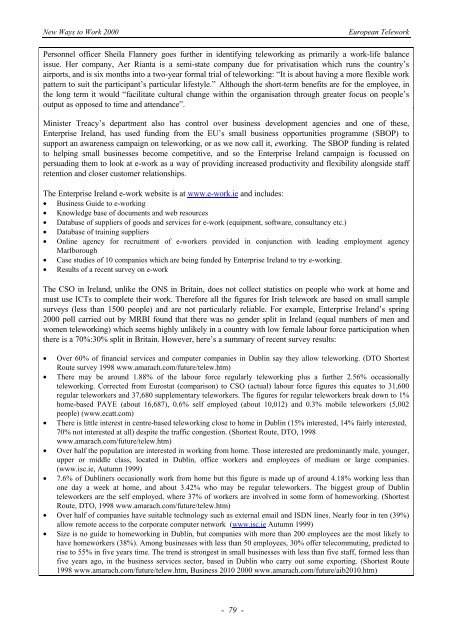eWORK 2000 - European Telework Week
eWORK 2000 - European Telework Week
eWORK 2000 - European Telework Week
- No tags were found...
You also want an ePaper? Increase the reach of your titles
YUMPU automatically turns print PDFs into web optimized ePapers that Google loves.
New Ways to Work <strong>2000</strong><strong>European</strong> <strong>Telework</strong>Personnel officer Sheila Flannery goes further in identifying teleworking as primarily a work-life balanceissue. Her company, Aer Rianta is a semi-state company due for privatisation which runs the country’sairports, and is six months into a two-year formal trial of teleworking: “It is about having a more flexible workpattern to suit the participant’s particular lifestyle.” Although the short-term benefits are for the employee, inthe long term it would “facilitate cultural change within the organisation through greater focus on people’soutput as opposed to time and attendance”.Minister Treacy’s department also has control over business development agencies and one of these,Enterprise Ireland, has used funding from the EU’s small business opportunities programme (SBOP) tosupport an awareness campaign on teleworking, or as we now call it, eworking. The SBOP funding is relatedto helping small businesses become competitive, and so the Enterprise Ireland campaign is focussed onpersuading them to look at e-work as a way of providing increased productivity and flexibility alongside staffretention and closer customer relationships.The Enterprise Ireland e-work website is at www.e-work.ie and includes:• Business Guide to e-working• Knowledge base of documents and web resources• Database of suppliers of goods and services for e-work (equipment, software, consultancy etc.)• Database of training suppliers• Online agency for recruitment of e-workers provided in conjunction with leading employment agencyMarlborough• Case studies of 10 companies which are being funded by Enterprise Ireland to try e-working.• Results of a recent survey on e-workThe CSO in Ireland, unlike the ONS in Britain, does not collect statistics on people who work at home andmust use ICTs to complete their work. Therefore all the figures for Irish telework are based on small samplesurveys (less than 1500 people) and are not particularly reliable. For example, Enterprise Ireland’s spring<strong>2000</strong> poll carried out by MRBI found that there was no gender split in Ireland (equal numbers of men andwomen teleworking) which seems highly unlikely in a country with low female labour force participation whenthere is a 70%:30% split in Britain. However, here’s a summary of recent survey results:• Over 60% of financial services and computer companies in Dublin say they allow teleworking. (DTO ShortestRoute survey 1998 www.amarach.com/future/telew.htm)• There may be around 1.88% of the labour force regularly teleworking plus a further 2.56% occasionallyteleworking. Corrected from Eurostat (comparison) to CSO (actual) labour force figures this equates to 31,600regular teleworkers and 37,680 supplementary teleworkers. The figures for regular teleworkers break down to 1%home-based PAYE (about 16,687), 0.6% self employed (about 10,012) and 0.3% mobile teleworkers (5,002people) (www.ecatt.com)• There is little interest in centre-based teleworking close to home in Dublin (15% interested, 14% fairly interested,70% not interested at all) despite the traffic congestion. (Shortest Route, DTO, 1998www.amarach.com/future/telew.htm)• Over half the population are interested in working from home. Those interested are predominantly male, younger,upper or middle class, located in Dublin, office workers and employees of medium or large companies.(www.isc.ie, Autumn 1999)• 7.6% of Dubliners occasionally work from home but this figure is made up of around 4.18% working less thanone day a week at home, and about 3.42% who may be regular teleworkers. The biggest group of Dublinteleworkers are the self employed, where 37% of workers are involved in some form of homeworking. (ShortestRoute, DTO, 1998 www.amarach.com/future/telew.htm)• Over half of companies have suitable technology such as external email and ISDN lines. Nearly four in ten (39%)allow remote access to the corporate computer network (www.isc.ie Autumn 1999)• Size is no guide to homeworking in Dublin, but companies with more than 200 employees are the most likely tohave homeworkers (38%). Among businesses with less than 50 employees, 30% offer telecommuting, predicted torise to 55% in five years time. The trend is strongest in small businesses with less than five staff, formed less thanfive years ago, in the business services sector, based in Dublin who carry out some exporting. (Shortest Route1998 www.amarach.com/future/telew.htm, Business 2010 <strong>2000</strong> www.amarach.com/future/aib2010.htm)- 79 -








